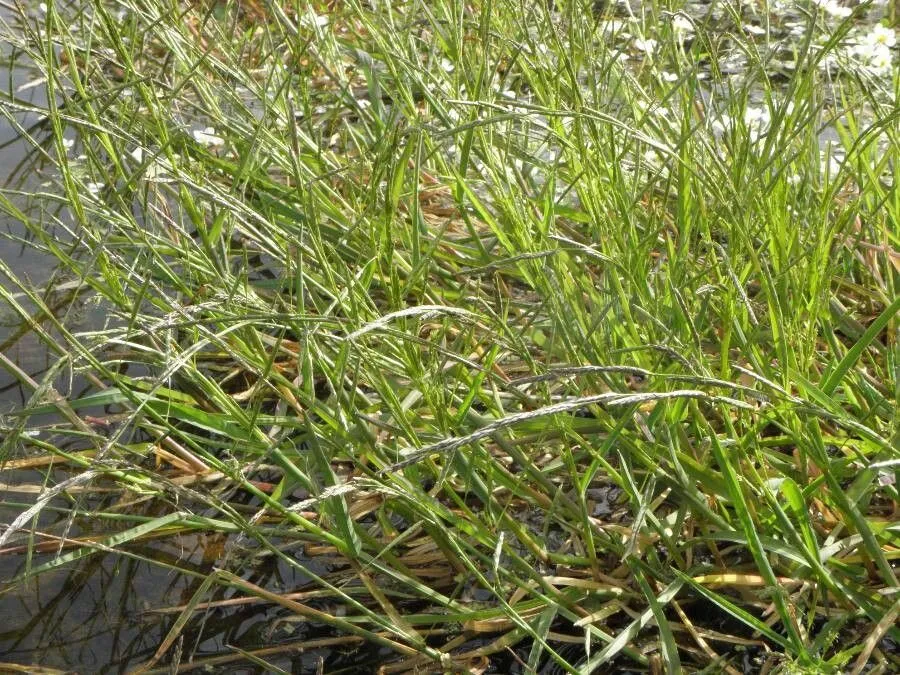
Author: Bréb.
Bibliography: Fl. Normandie, ed. 3: 354 (1859)
Year: 1859
Status: accepted
Rank: species
Genus: Glyceria
Vegetable: False
Observations: Macaronesia, Europe, Morocco
Waxy mannagrass, scientifically known as Glyceria declinata, is a notable species within the Poaceae family, a large and nearly ubiquitous family of grasses. First described by Bréb. in the third edition of “Fl. Normandie” in 1859, this plant has since captured the attention of botanists and ecologists due to its distinct characteristics and geographical distribution.
Characterized by its glistening, wax-coated leaves that give the plant its common name, Waxy mannagrass is easily identified in the field. Its leaves display a unique sheen that can often serve as a distinguishing feature when compared to other grass species within the same habitat.
Native to a range of regions, Glyceria declinata is predominantly found across Macaronesia, Europe, and parts of Morocco. Its adaptability to different climates and soils highlights its ecological versatility. In Europe, the plant often thrives in wetlands and along water bodies, where its preference for moist environments can be most effectively met. Additionally, the plant’s presence in diverse locales underscores its ability to survive and propagate in various environmental conditions.
Waxy mannagrass plays an important role within its ecosystem, offering both environmental benefits and contributing to biological diversity. By stabilizing soil with its extensive root system, it helps in preventing soil erosion, thus maintaining the integrity of its habitat. This, in turn, supports other flora and fauna, bolstering the health of the ecosystem as a whole.
For botanists and plant enthusiasts, Glyceria declinata represents an intriguing subject of study due to its resilient nature and distinctive physical traits. Its historical context, being identified and recorded more than a century ago, adds another layer to its significance, serving as a testament to the enduring interest in and importance of plant biodiversity.
Deu: blaugrüner schwaden
Nor: buesøtgras
Dan: tandet sødgræs
Eng: waxy mannagrass, small sweet-grass, waxy manna grass, small flote-grass, low glyceria
Nld: getand vlotgras
Fra: glycérie dentée, glycérie inclinée
Swe: blågrönt mannagräs, bågböjt mannagräs
Cym: melyswellt llwydlas, perwellt glaswyrdd, perwellt llwydlas
En: Waxy mannagrass, Small Sweet-grass, Waxy Manna Grass, Small Flote-Grass, Low glyceria, Small sweet grass
Da: Tandet sødgræs
Nl: Getand vlotgras
Fi: Pikkusorsimo
Fr: Glycérie dentée, Glycérie inclinée
De: Blaugrüner Schwaden, Blaugrünes Süßgras
It: Gramignone atlantico
No: Buesøtgras
Sv: Blågrönt mannagräs, Bågböjt mannagräs
Cy: Melyswellt Llwydlas, Perwellt Glaswyrdd, Perwellt Llwydlas
© copyright of the Board of Trustees of the Royal Botanic Gardens, Kew.
Taken May 23, 2022 by Diego Alex (cc-by-sa)
Taken Aug 15, 2005 by Photoflora – Jean-Luc TASSET (©)
Taken May 4, 2015 by Tela Botanica − Jean-Luc Gorremans (cc-by-sa)
Taken May 4, 2015 by Tela Botanica − Jean-Luc Gorremans (cc-by-sa)
Taken Aug 15, 2005 by Photoflora – Benoit BOCK (©)
Taken Aug 15, 2005 by Photoflora – Jean-Luc TASSET (©)
Taken Aug 15, 2005 by Photoflora – Jean-Luc TASSET (©)
Taken Jun 16, 2013 by Tela Botanica − Alexandre Maccaud (cc-by-sa)
Taken Jul 7, 2009 by Tela Botanica − Mathieu MENAND (cc-by-sa)
Taken Apr 1, 2021 by S100 (cc-by-sa)
Taken Aug 15, 2005 by Photoflora – Jean-Luc TASSET (©)
Taken Aug 15, 2014 by Photoflora – Jean-Luc TASSET (©)
Taken Jul 15, 1999 by Photoflora – Jean-Luc TASSET (©)
Taken May 4, 2015 by Tela Botanica − Jean-Luc Gorremans (cc-by-sa)
Taken Jul 15, 2006 by Photoflora – Benoit BOCK (©)
Growth habit: Graminoid
Ph maximum: 7.5
Ph minimum: 7.0
Light: 7
Atmospheric humidity: 9
Bloom months: [‘may’, ‘jun’, ‘jul’, ‘aug’]
Soil nutriments: 7
Family: Myrtaceae Author: (F.Muell.) K.D.Hill & L.A.S.Johnson Bibliography: Telopea 6: 402 (1995) Year: 1995 Status:…
Family: Rubiaceae Author: Pierre ex A.Froehner Bibliography: Notizbl. Bot. Gart. Berlin-Dahlem 1: 237 (1897) Year:…
Family: Sapindaceae Author: Koidz. Bibliography: J. Coll. Sci. Imp. Univ. Tokyo 32(1): 38 (1911) Year:…
Family: Asteraceae Author: A.Gray Bibliography: Pacif. Railr. Rep.: 107 (1857) Year: 1857 Status: accepted Rank:…
Family: Fabaceae Author: Medik. Bibliography: Vorles. Churpfälz. Phys.-Ökon. Ges. 2: 398 (1787) Year: 1787 Status:…
Family: Aspleniaceae Author: (Cav.) Alston Bibliography: Bull. Misc. Inform. Kew 1932: 309 (1932) Year: 1932…